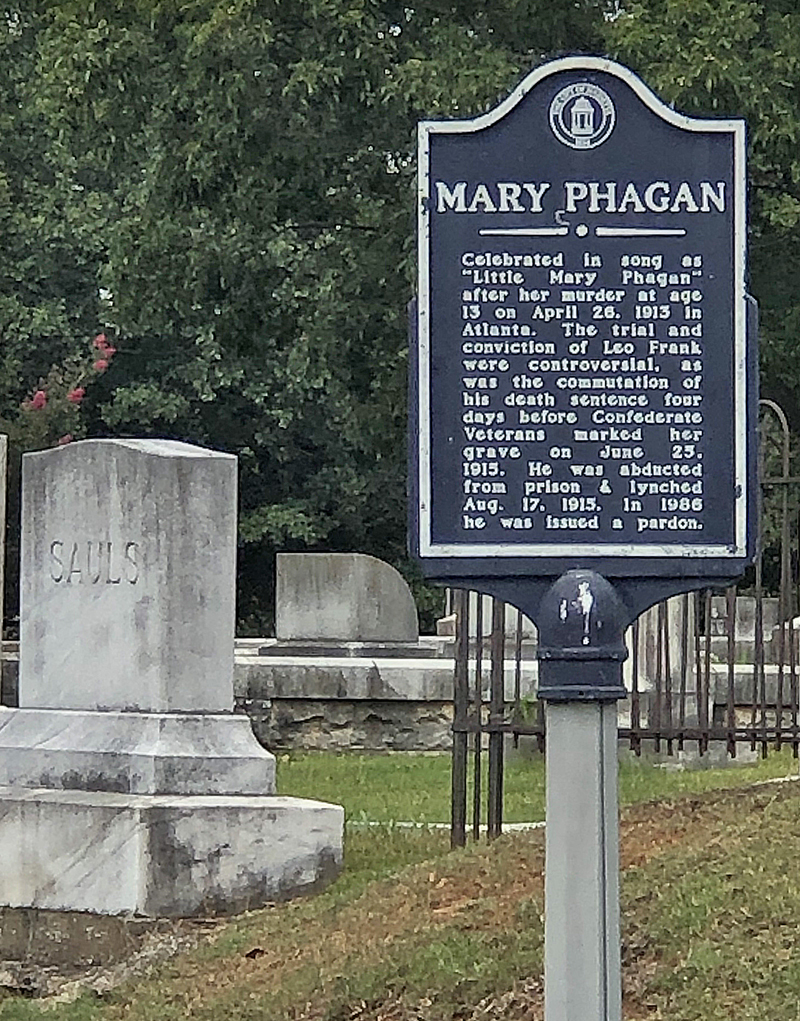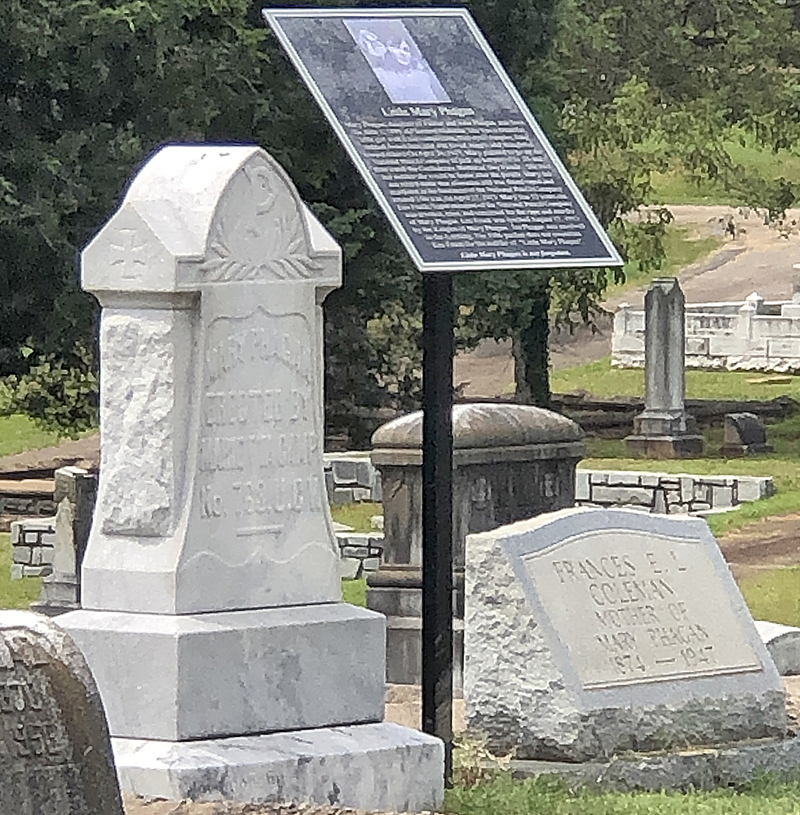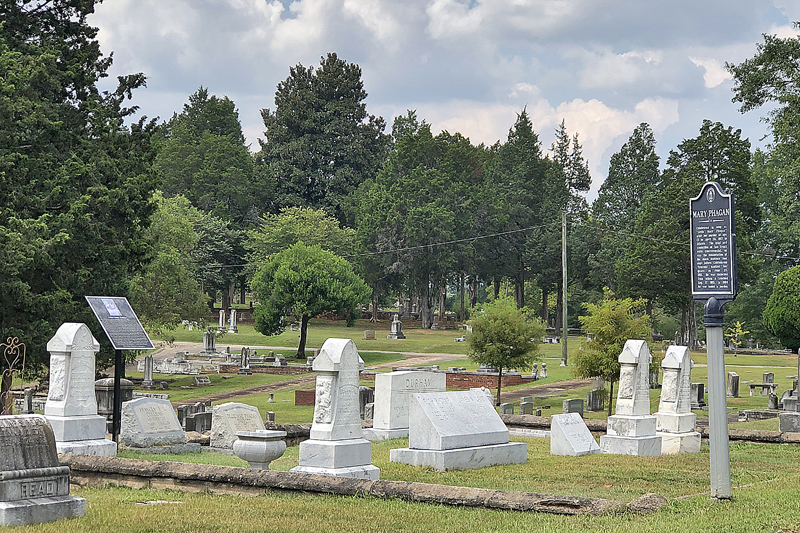Note: This article pertaining to The Grave Site of Mary Phagan, Who Was Murdered at 13 Years of Age was originally published on Wednesday, August 19, 2020 at 9:23 in the evening and has been updated.
Tucked away in a plot of the Marietta City Cemetery in a quiet part of Marietta near the railroad tracks is the grave site of Mary Phagan, who was murdered on Saturday, April 26, 1913 when she was only 13 years old; and her strangled body was found by the night watchman near an incinerator in the rear of the basement of the National Pencil Company, where she worked as an employee.
The Grave Site of Mary Phagan, Who Was Murdered at 13 Years of Age
Leo Max Frank was a Jewish man who is thought to be wrongfully convicted of the murder of Phagan. Frank was a superintendent of the National Pencil Company. Did he attempt to sexually assault Mary Phagan — or did someone else kill her and frame Frank?
The Knights of Mary Phagan swore revenge for her murder — which led to the lynching of Leo Frank.

A City of Marietta historic marker indicates the grave site of Mary Phagan — and the text on it reads as follows:
Celebrated in song as “Little Mary Phagan” after her murder at age 13 on April 26, 1913 in Atlanta. The trial and conviction of Leo Frank were controversial, as were the commutation of his death sentence four days before Confederate Veterans marked her grave on June 25, 1915. He was abducted from prison & lynched Aug. 17, 1915. In 1986, he was issued a pardon.

The plaque which is adjacent to the white gravestone of Mary Phagan — which is on the left side of the photograph — has her photograph and the following statement on it:
Little Mary Phagan
Mary Phagan, daughter of Fannie and John Phagan, was born on June 1, 1899 in Florence Alabama. She was a beautiful little girl with a fair complexion, blue eyes, dimples, long reddish brown hair, and was jovial, happy, and thoughtful toward others. On April 26, 1913, Mary planned to go up to the National Pencil Company to pick up her pay of $1.20 and then watch the Confederate Memorial Day Parade. She told her mother she would be home after the parade. Mary did not return home that afternoon and was found raped and murdered in the basement of the National Pencil Company around 3:00 a.m. on April 27, 1913. Mary was 13 years old. Leo Frank, Superintendent of the National Pencil Company was arrested, tried, and convicted for the rape and murder of Mary Phagan. Leo Frank was lynched August 17, 1915 by the Knights of Mary Phagan. No Phagan was involved in the lynching. The 1986 pardon does not exonerate Leo Frank for the murder of “Little Mary Phagan.”
Little Mary Phagan is not forgotten.
Fannie Phagen — whose gravestone is marked as Frances E.L. Coleman — was the mother of Mary Phagan; and her grave site is just north of that of Mary Phagan, which on the right in the photograph shown above. She died in 1947.
On the somewhat ornate white gravestone of Mary Phagan itself is the following message:
Mary Phagan
Erected by Marietta Camp
No. 763, U.C.V.
Final Boarding Call
The grave site of Mary Phagan is located on the southern side of Marietta City Cemetery in Marietta in Georgia; and although the entrance to the cemetery is located on West Atlanta Street, you can see the grave site from Cemetery Street.
Marietta City Cemetery
395 Powder Springs Street
Marietta, Georgia 30064
770-429-1115
Open daily from dawn until dusk
Click here for additional information pertaining to the cemetery itself.
No official parking spots are designated for the grave site of Mary Phagan — but you can park within the cemetery or out on the street, as both West Atlanta Street and Cemetery Street are dead end streets.
No admission is charged to visit this site. No facilities are available either. Group tours are by appointment.
As to whether the lynching of Leo Frank on Tuesday, August 17, 1915 was a verifiable act of justice or simply a brazen act of anti-Semitism, judge for yourself based on both the evidence and conjecture pertaining to the case as presented by this article at Wikipedia — which includes citations if you want to check the sources — as well as this article and book written by Steve Oney and statements from Mary Phagan-Kean, which includes this paper of the official position of the Phagan family.
One thing is for certain: this controversial case represents a dark era in the state of Georgia…
All photographs ©2020 by Brian Cohen.

